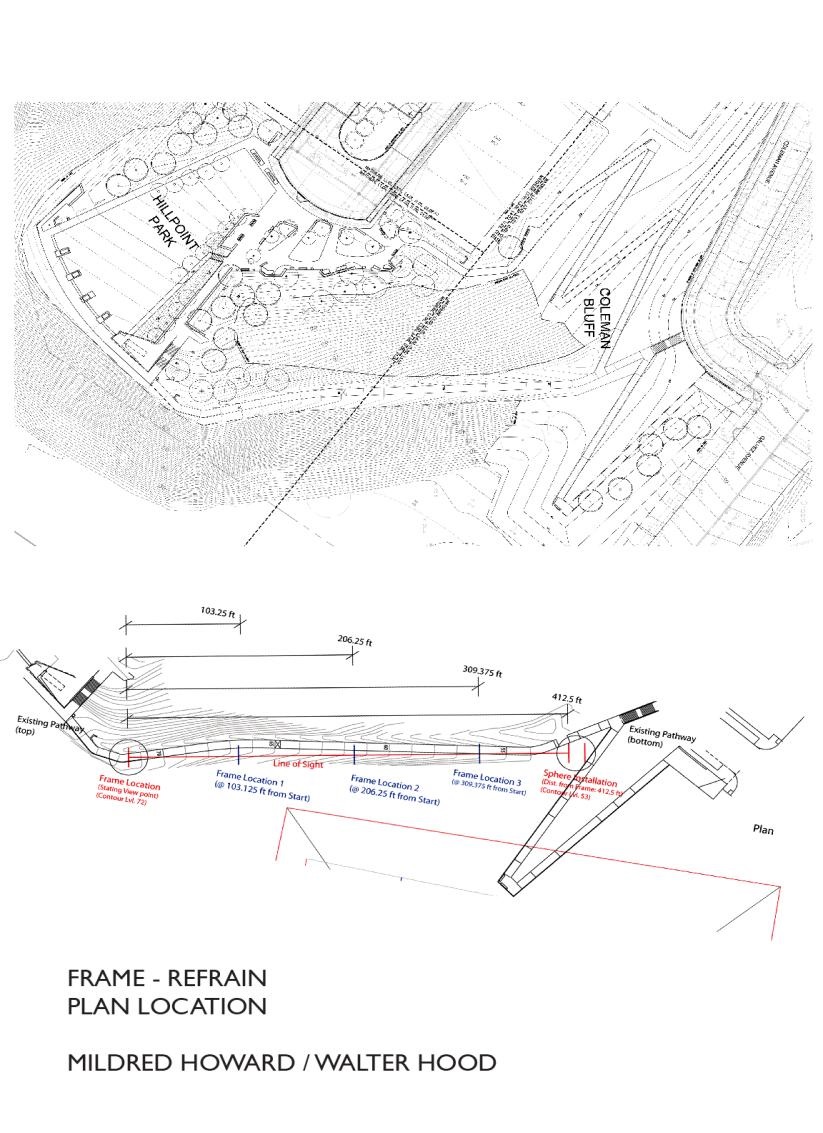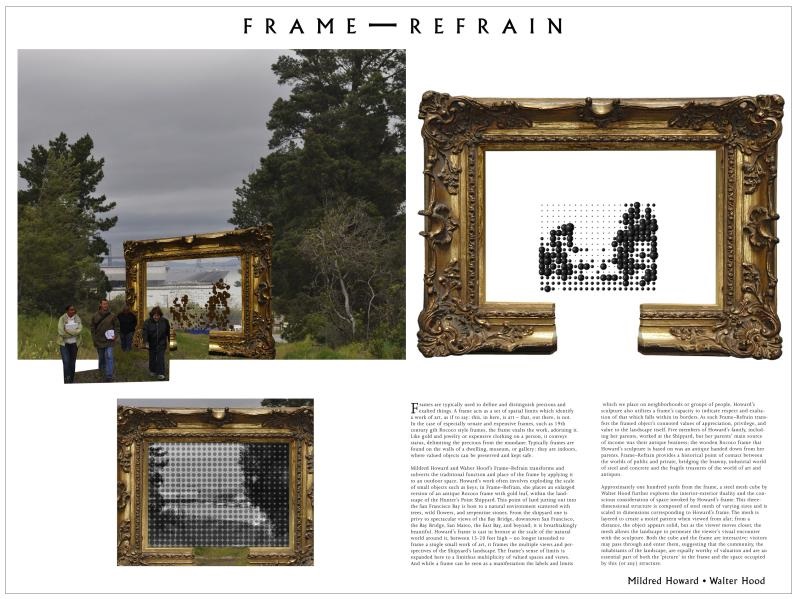Mildred Howard with Walter Hood - The Frame Refrain
Mildred Howard with Walter Hood - Frame Refrain
[ARTIST BACKGROUND] Artist Mildred Howard and artist and landscape architect Walter Hood, are
internationally recognized creative practitioners partnering to create a pair of interactive artworks. Both Howard
and Hood are recognized for a broad range of public projects found in museums, galleries and inner-city
neighborhoods.
Howard is recognized for art and significant public art commissions, her work is exhibited in galleries
internationally. Mildred Howard’s artworks poses often piercing questions about culture or identity. Howard
received an Associate of Art Degree, College of Alameda and a Master of Fine Art Degree from John F.
Kennedy University, Orinda, California. Her appreciation for the history of the Shipyard is personal as Howard
was born in San Francisco following her family’s move from Galveston, Texas. Her parents worked at the
Shipyard, however her parents’ main source of income was their antique business.
Walter Hood is recognized internationally for his design, contributions to the professional field and to
environments which often embody the unique spirit of a community. He is the principal of Hood Design in
Oakland and a professor of landscape architecture at the University of California at Berkeley. Walter Hood
received a Bachelor of Science Degree, North Carolina State University and a Master of Landscape Architecture
Degree and Master of Architecture Degree, University of California at Berkeley and a Master of Fine Art Degree
from the School of the Art Institute of Chicago.
[PROPOSED ARTWORK] Mildred Howard and Walter Hood’s Frame–Refrain transforms and subverts the
traditional function and place of the frame by applying it to an outdoor space.
Howard places an enlarged version of an antique Rococo frame with gold leaf, within the landscape of the
Hunters Point Shipyard. Howard’s frame at the scale of the natural world around it, between 15-20 feet high – no
longer intends to frame a single small work of art, it frames the multiple views and perspectives of the Shipyard’s
landscape. The frame’s sense of limits is expanded here to a limitless multiplicity of valued spaces and views.
And while a frame can be seen as a manifestation the labels and limits which we place on neighborhoods or
groups of people, Howard’s sculpture also utilizes a frame’s capacity to indicate respect and exaltation of that
which falls within its borders. As such Frame–Refrain transfers the framed object’s connoted values of
appreciation, privilege, and value to the landscape itself. Frame–Refrain provides a historical point of contact
between the worlds of public and private, bridging the brawny, industrial world of steel and concrete and the
fragile treasures of the world of art and antiques. The frame is interactive: visitors may pass through it,
suggesting that the community, the inhabitants of the landscape, are equally worthy of valuation and are an
essential part of the ‘picture’.
Approximately one hundred yards from the frame, a three dimensional structure by Walter Hood further explores
the interior-exterior duality and the conscious consideration of space invoked by Howard’s frame. Hoods
structure, which is aligned with the frame, captures the currently visible view of the bay bridge when walking
down the path from the frame towards his piece. This three-dimensional structure is constructed of circular
spheres connected within a triangulated metal frame and is scaled to dimensions corresponding to Howard’s
frame. The spheres are pixels that create the picture of the current view which will be partly blocked by buildings
once the shipyard development is completed. It will therefore be ‘history’, but the memory of it remains.
[ARTIST INSPIRATION] Howard comments on her inspiration and investigation of the meaning of a frame …
Frames are typically used to define and distinguish precious and exalted things. A frame acts as a set of spatial
limits which identify a work of art, as if to say: this, in here… is art – that, out there… is not. In the case of
especially ornate and expensive frames, such as 19th century gilt Rococo style frames, the frame exalts the
work, adorning it. Like gold and jewelry or expensive clothing on a person, it conveys status, delimiting the
precious from the mundane. Typically frames are found on the walls of a dwelling, museum, or gallery: they are
indoors, where valued objects can be preserved and kept safe.
Howard was further inspired by her personal family history - the wooden Rococo frame that Howard’s artwork is
based on was an antique handed down from her parents. Frame–Refrain provides a historical point of contact
between the worlds of public and private, bridging the brawny, industrial world of steel and concrete and the
fragile treasures of the world of art and antiques.
 |
 |